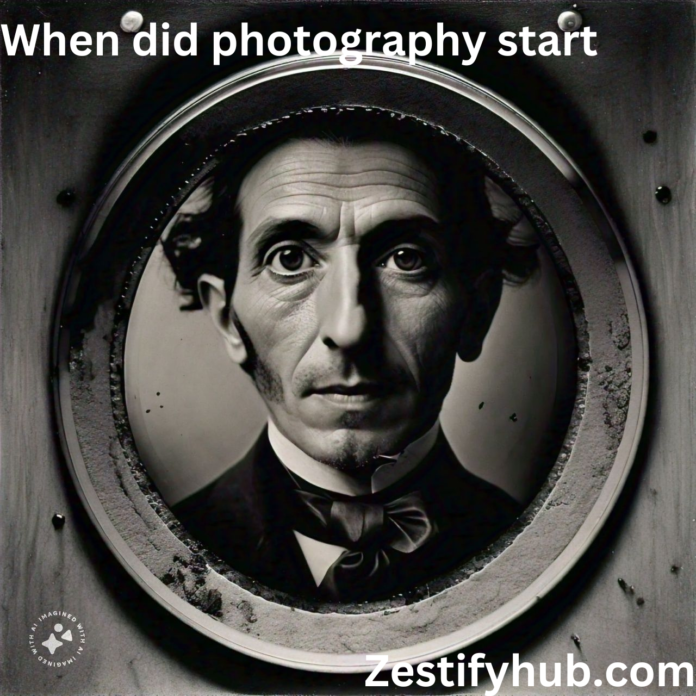Photography, a medium that has revolutionized the way we capture and preserve moments in time, has a rich and fascinating history dating back centuries. In this article, we embark on a journey to explore the origins of photography, tracing its evolution from early precursors to the modern marvels of image-making. We’ll discuss in this article about when did photography start.
Introduction to the Evolution of Photography
Photography’s journey begins with the human desire to immortalize the world around us, to freeze moments in time and preserve them for posterity. From humble beginnings to groundbreaking innovations, the evolution of photography is a testament to human ingenuity and creativity.
Early Precursors to Photography
Camera Obscura
The origins of photography can be traced back to the concept of the camera obscura, an optical device that projects an inverted image of the surrounding environment onto a surface. While not capable of capturing permanent images, the camera obscura laid the groundwork for the development of photographic technology. We’ll discuss in this article about when did photography start.
Pioneering Innovations in Photography
Daguerreotype and Calotype
In the early 19th century, two pioneering techniques emerged that would revolutionize the field of photography: the daguerreotype and the calotype. Developed by Louis Daguerre and William Henry Fox Talbot respectively, these methods allowed for the creation of permanent images on light-sensitive surfaces, marking the birth of modern photography.
Dawn of Modern Photography
Birth of the First Photograph
The year 1826 marks a significant milestone in the history of photography with the creation of the world’s first photograph by Joseph Nicéphore Niépce. Known as “View from the Window at Le Gras,” this primitive image captured the essence of photography’s potential and set the stage for further advancements in the field. We’ll discuss in this article about when did photography start.
Evolution of Photographic Processes
Throughout the 19th and 20th centuries, photography underwent rapid evolution, with advancements in chemical processes, equipment design, and artistic techniques. From the advent of film photography to the digital revolution of the 21st century, photographers have continually pushed the boundaries of what is possible, expanding the medium’s creative potential.
When did photography start
Photography as we know it today began to take shape in the early 19th century. The pivotal moment came in 1826 when Joseph Nicéphore Niépce successfully captured the first known permanent photograph, titled “View from the Window at Le Gras,” using a process known as heliography. This image marked the beginning of photography, albeit with lengthy exposure times and rudimentary techniques. We’ll discuss in this article about when did photography start.
Niépce’s work laid the foundation for further advancements in the field. In 1839, Louis Daguerre introduced the daguerreotype process, which reduced exposure times significantly and produced clearer images. This innovation, along with William Henry Fox Talbot’s development of the calotype process around the same time, revolutionized photography and paved the way for its widespread adoption. From these humble beginnings, photography has evolved into a multifaceted art form and an indispensable tool in communication, documentation, and artistic expression.
Impact and Influence of Photography
Documenting History and Culture
Photography has played a pivotal role in documenting the human experience, capturing moments of triumph and tragedy, joy and sorrow. From iconic images that shape our collective memory to intimate snapshots that preserve cherished memories, photography serves as a powerful tool for preserving history and culture. We’ll discuss in this article about when did photography start.
Shaping Visual Arts and Communication
In addition to its documentary function, photography has also had a profound impact on the visual arts and communication. From fine art photography that challenges our perceptions of reality to commercial photography that shapes our consumer culture, images have the power to evoke emotion, provoke thought, and inspire action.
Conclusion
In conclusion, the origins of photography are a testament to human curiosity, creativity, and innovation. From the humble beginnings of the camera obscura to the digital age of smartphones and social media, photography has evolved into a powerful medium that shapes how we see and understand the world around us. As we continue to push the boundaries of what is possible, may we remember the pioneers who paved the way for this remarkable journey of image-making. We’ll discuss in this article about when did photography start.
FAQs (Frequently Asked Questions)
- When was the first photograph ever taken?
- The first photograph, known as “View from the Window at Le Gras,” was taken by Joseph Nicéphore Niépce in 1826.
- What are some of the earliest forms of photography?
- Early forms of photography include the daguerreotype, calotype, and ambrotype, each of which contributed to the evolution of photographic technology. We’ll discuss in this article about when did photography start.
- How has photography evolved?
- Photography has undergone significant evolution, from the advent of film photography to the digital revolution of the 21st century, with advancements in technology, equipment, and artistic techniques driving its development.
- What impact has photography had on society and culture?
- Photography has had a profound impact on society and culture, serving as a powerful tool for documenting history, shaping visual arts, and communicating ideas and emotions. We’ll discuss in this article about when did photography start.
- What role does photography play in the modern world?
- In the modern world, photography serves as a ubiquitous medium for self-expression, communication, and documentation, allowing individuals to capture and share moments of their lives with the world.


